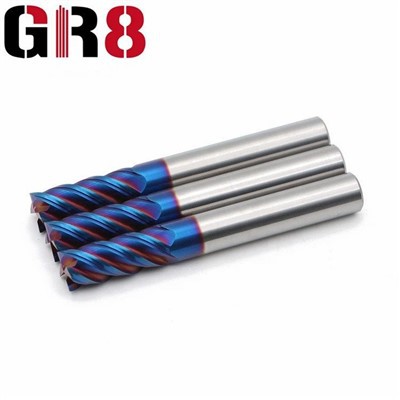Roughing End Mill
Best(Hebei) Technology Co., Ltd. is subordinate to Best Cemented Carbide Technology Co., Ltd. under the Sheng gong Group. The company's main products include flat end mill, ball nose end mill, roughing end mill, long neck end mill, spiral flute bits, taper ball nose endmill and so on.
Why choose us
Rich experience
After more than ten years of development, GR8 brand precision cutting tools have become a well-known brand in the industry, occupying a large market share in China. At the same time, it is widely recognized by more and more customers from more than 50 countries.
Customized services
The purpose of the company is to provide customers with the most cost-effective products, and provide quality services. Meanwhile, in order to meet the needs of different customers, the company's professional technicians will provide customized services for professional customers.
Advanced equipment
The company keeps pace with the times, introduces the most advanced production technology and the most advanced CNC cutting tool production equipment at home and abroad, combines its own conditions, plans its own development path, and improves its own production process.
Sales market
After years of development, the GR8 brand has successfully expanded into markets in more than 50 countries including Japan, Australia, Asia, the Middle East, Europe, and the Americas, and has been recognized by more and more customers.
Tooth geometry
Aggressive tooth design: Features larger, more widely spaced teeth compared to finishing end mills.
Wavy or serrated tooth profile: Breaks up chips effectively, reducing cutting forces and preventing chip build-up.
Flute design
Deeper flutes: Accommodate larger chip loads and improve chip evacuation.
Spiral flute design: Enhances chip removal and reduces cutting forces.
Material and coating
Tougher materials: Made from high-speed steel (HSS) or carbide to withstand heavy cutting conditions.
Protective coatings: Often applied to improve wear resistance, heat resistance, and tool life.
Overall design
Larger diameter: Allows for higher material removal rates.
Shorter flute length: Provides greater rigidity and reduces vibration.

Product Specifications
|
SPECIFICATION |
D1 |
L1 |
D |
L |
|
D3.175*12*D3.175*38L |
3.175mm |
12mm |
3.175mm |
38L |
|
D3.175*17*D3.175*38L |
3.175mm |
17mm |
3.175mm |
38L |
|
D3.175*22*D3.175*45L |
3.175mm |
22mm |
3.175mm |
45L |
|
D3.175*25*D3.175*45L |
3.175mm |
25mm |
3.175mm |
45L |
|
D4*17*D4*50L |
4mm |
17mm |
4mm |
50L |
|
D4*22*D4*50L |
4mm |
22mm |
4mm |
50L |
|
D4*25*D4*50L |
4mm |
25mm |
4mm |
50L |
|
D4*32*D4*60L |
4mm |
32mm |
4mm |
60L |
|
D6*17*D6*50L |
6mm |
17mm |
6mm |
50L |
|
D6*22*D6*50L |
6mm |
22mm |
6mm |
50L |
|
D6*25*D6*50L |
6mm |
25mm |
6mm |
50L |
|
D6*32*D6*60L |
6mm |
32mm |
6mm |
60L |
|
D6*42*D6*70L |
6mm |
42mm |
6mm |
70L |
|
D6*52*D6*80L |
6mm |
52mm |
6mm |
80L |
|
D6*62*D6*90L |
6mm |
62mm |
6mm |
90L |
|
D8*25*D8*60L |
8mm |
25mm |
8mm |
60L |
|
D8*32*D8*60L |
8mm |
32mm |
8mm |
60L |
|
D8*42*D8*70L |
8mm |
42mm |
8mm |
70L |
|
D8*52*D8*80L |
8mm |
52mm |
8mm |
80L |
|
D8*62*D8*90L |
8mm |
62mm |
8mm |
90L |
|
D10*32*D10*75L |
10mm |
32mm |
10mm |
75L |
|
D10*42*D10*85L |
10mm |
42mm |
10mm |
85L |
|
D10*62*D10*95L |
10mm |
62mm |
10mm |
95L |
Components of roughing end mill

Shank
The shank is the side of the end mill that is secured into the CNC machine’s tool holder. The shank must be solidly constructed, as any instability can lead to inaccuracies in the milling process.
Flutes
These are the deep helical grooves running up the cutter, where the chips form. Roughing end mills usually have more flutes than regular end mills, which supports the rapid removal of material.


Cutting edge
This is the sharp edge of the flutes that cuts into the workpiece. In roughing end mills, the cutting edges are serrated, which helps disperse the force exerted on the tool.
End and tip
The end of the mill would either be flat (square end mill) or rounded (ball end mill), while the tip determines its ability to plunge into the material (center cutting or non-center cutting).

Packaging

Shipping

Customize the Ordering Process


Certifications




FAQ








